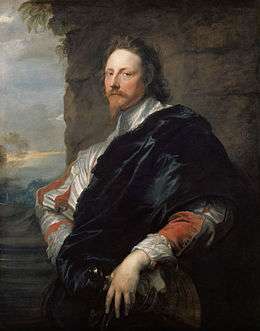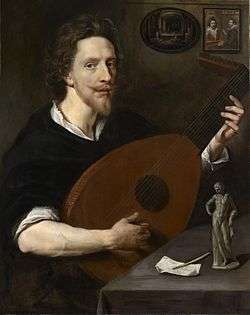Nicholas Lanier

Nicholas Lanier, sometimes Laniere (baptised at Greenwich 10 September 1588 – 24 February 1666) was an English composer and musician; the first to hold the title of Master of the King's Music from 1625 to 1666, an honour given to musicians of great distinction. He was the court musician, a composer and performer and Groom of the Chamber in the service of King Charles I and Charles II. He was also a singer, lutenist, scenographer and painter.
Biography

Nicholas Lanier was a descendant of a French family of royal musicians, the Lanière family, who were Huguenots. His father and grandfather left France to escape persecutions.[2] The family settled in England in 1561. Nicholas Lanier was the son of John Lanier, who was the son of Nicholas Lanier the Elder, court musician to the French King Henry II of France. His maternal grandfather was another royal musician, Mark Anthony Galliardello. He was first taught by his father, John, who played the sackbut. In 1613 he composed a masque for the marriage of the Earl of Somerset jointly with Giovanni Coperario and others.[3]
He also wrote music, sang and made sets for Thomas Campion and Ben Jonson's The Masque of Augurs and Lovers Made Men.[4][5]
In the 1610s, Lanier was appointed as a lutenist to the King's orchestra and a singer in the King's Consorte from 1625 to 1642. He also sang and played the viola da gamba. Lanier was also appointed as Groom of the Chamber for the Queen's Privy Chamber in 1639.[6]
From 1625 he made a series of visits to Italy to collect paintings for King Charles I, including most of the art collection of the Dukes of Mantua. During his travells he heard the new Italian music being written by the likes of Claudio Monteverdi. This led to him being one of the first English composers to introduce monody and recitative to England. It was Lanier who, when his own portrait was painted by the Flemish painter van Dyck in Antwerp, convinced the King to bring Van Dyck to England, where Van Dyck became the leading court painter. The portrait displays the special attitude of studied carelessness, called sprezzatura, recommended in the The Book of the Courtier by Baldassare Castiglione, as "a certain nonchalance, so as to conceal all art and make whatever one does or says appear to be without effort and almost without any thought about it".[7] Lanier's portrait by van Dyck hangs today in Vienna at the Kunsthistoriches Museum.[8]
In 1626, Lanier became the first to hold the title Master of the King's Music in 1626; an honour given a musician of great distinction. The office of Master of the King's Musick is the equivalent to the title of the Poet Laureate. During the Commonwealth of England he lived in the Netherlands, but returned after the Restoration to resume his duties in 1660. When he returned to England, he became music master to Charles II. He made several sceneries, like for example for Ben Jonson’s Lovers Made Men. There is only one painting which can be identified as being made by Lanier, a self-portrait in the music faculty of Oxford University.[9][10][11] Lanier died in 1666 in East Greenwich.
Court offices
| Court offices | ||
|---|---|---|
| New title | Master of the King's Music 1625–1666 (role abolished 1649–1660) |
Succeeded by Louis Grabu |
See also
References
- ↑ "A new portrait of Nicholas Lanier". em.oxfordjournals.org. Retrieved 2015. Check date values in:
|access-date=(help) - ↑ "www.eccchistory.org". Retrieved 2015. Check date values in:
|access-date=(help) - ↑ "Nicholas Lanier (Lanière)". www.hoasm.org. Retrieved 2015. Check date values in:
|access-date=(help) - ↑ "biography/Nicholas-Lanier". global.britannica.com. Retrieved 2015. Check date values in:
|access-date=(help) - ↑ "Nicholas Lanier (Lanière)". www.hoasm.org. Retrieved 2015. Check date values in:
|access-date=(help) - ↑ "Nicholas Lanier (Lanière)". www.hoasm.org. Retrieved 2015. Check date values in:
|access-date=(help) - ↑ Castiglione 2002, p. 32.
- ↑ "nicolas-lanier". www.google.com. Retrieved 2015. Check date values in:
|access-date=(help) - ↑ "biography/Nicholas-Lanier". global.britannica.com. Retrieved 2015. Check date values in:
|access-date=(help) - ↑ "The Royal Household, Master of The Queens Music". www.royal.gov.uk. Archived from the original on 23 September 2015.
- ↑ "The Musical Times, June 1953, pp. 255–258". JSTOR 934669.
Bibliography
 | |
|
| |
|
|
- Callon, Gordon J., Nicholas Lanier: The complete works, (1994), Severinus Press, ISBN 0-86314-224-9.
External links
| Wikimedia Commons has media related to Nicholas Lanier. |